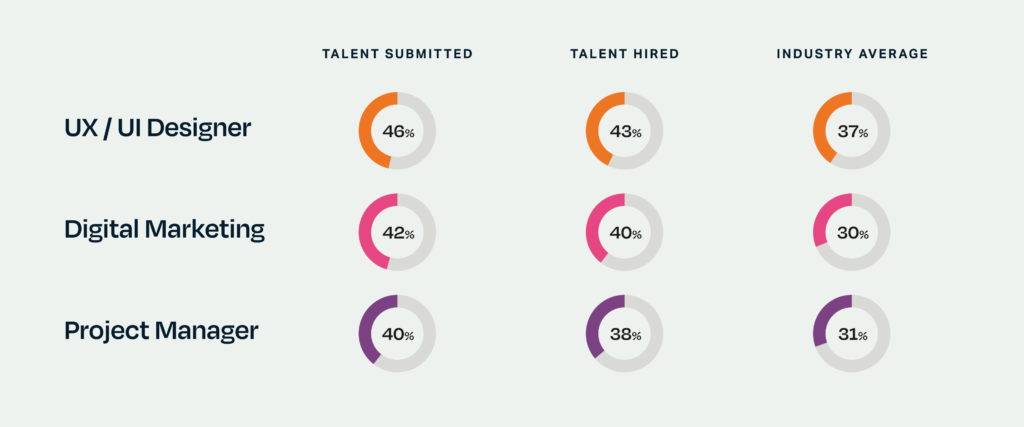

Key Takeaways
- DEI is incorporated into every aspect of Aquent's business, collaborating with professional organizations and universities to reach diverse communities.
- Aquent's diversity hiring team supports clients and collects voluntary demographic data from applicants and employees to measure progress.
- Specialized tools are used to eliminate biased language from job descriptions and to anonymize resumes.
- Aquent continues to improve its own DEI practices and offers a recruiting solution called Diversity+ for clients.
This article from Aishu Challa is about what inspired our diversity recruiting solution. To learn more about how to improve your organization's diversity, equity, and inclusion, check out these new guides: Helpful Diversity Recruiting Strategies You Need To Know and Diversity Recruiting Tools to Match Your Organization.
There is no question that 2020 brought the lack of diversity, equity, and Inclusion, (DEI) in our workplaces to the front of our collective minds. While Aquent is a minority-owned business and diversity has always been an important value, we are not perfect nor exempt from needing to work harder to make progress.
Over the past 18 months, we've taken a critical look at all aspects of our business — particularly how we recruit new Aquenters — and we've started taking action to change how we operate. This isn't some initiative or project with a start and end date. We recognize that the only way to truly make lasting change is to build DEI into every aspect of how we work, and that's exactly what we're doing.
The challenges we've faced and the approaches we've taken have informed the development of a diversity recruiting solution for our clients called Diversity+. Leading the development of Diversity+ has been an amazing opportunity for me professionally and personally, as diversity has been a lifelong passion. Not to mention, I have built my career as a woman of color in both a male-dominated role and industry. It was exciting to take on the challenge of helping other companies on their DEI journeys and making the workplace more diverse, equitable, and inclusive. Here are some of the most valuable things we've learned along the way.
How do you start finding more diverse candidates?
When we pledged to address our diversity shortcomings, we started at how we search for and recruit candidates. Right now, more people than ever before are looking for new job opportunities, and remote work has opened up the talent pool to the entire country. But that doesn't make sourcing diverse talent easier, even for a company like Aquent — a company of many, MANY recruiters.
In the work we did internally, our employee-led DEI council identified organizations, groups, institutions, and universities that we could collaborate with to reach diverse communities. Additionally, we decided to partner with the largest affinity job network, Professional Diversity Network. As the only staffing firm on their platform, we automatically post every open job to their many specialized career sites, including Asian Career Network, Black Career Network, iHispano, Military 2 Career, Out Professional Network, Pro Able, and Women's Career Channel.
This outreach is only part of the equation. We also created a diversity hiring team to support our clients. These dedicated recruiters are responsible for fostering and maintaining relationships with candidates from underrepresented groups. We've learned that focused effort is critical to moving the needle. Without accountability, other priorities can get in the way, and diversity recruiting can fall off the radar.
How do you measure how you're doing?
If you do not know where the problem is, how can you solve it? You need to start with data, plain and simple. Data is critically important to the success of any DEI program, and yet it's a big challenge for so many companies. That's why when we collect information from our applicants and our employees (whether internal staff or talent), we ask voluntary questions about their demographics (such as gender identity, ethnicity, and ability status) as well. It's also why we built robust reporting along the recruitment funnel into our Diversity+ solution.
- 52% of our talent community identify as female.
- 41% identify as Black, Indigenous, and People of Color.
- 13% of our talent community identify as LGBTQIA+.
Some insights from voluntary demographic data from talent applications since March of 2021
The data doesn't lie. It tells you how well (or poorly) you're doing to improve the representation of specific groups, like veterans or the LGBTQIA+ community. And it reveals patterns where candidates aren't progressing to the next step or where they're deciding to step back from the process. Using these insights, we can work with clients to examine what their hiring process looks like and how it might be working against their DEI efforts. From our engagements leveraging Diversity+, we've seen a favorable impact in building a more diverse talent pool.
How we are doing against the industry average in two dimensions in diversity since March of 2021.
Female Representation:

BIPOC Representation:

What can you do about unconscious bias?
Whether we like to admit it or not, we all are biased. And that bias surfaces unintentionally (hence, unconscious bias). Take a quick bias quiz to see where your biases exist. These biases may come out in subtle ways throughout the recruiting and hiring processes. For example, does the job ad contain gender-biased language? Does it ask for a laundry list of qualifications that are almost impossible to meet? What about how candidates are evaluated — starting with the resume through to the interview and final decision-making process? Are you automatically disqualifying candidates that didn't attend what you consider a prestigious school?
One of the first steps to mitigate bias is to be aware of it, so you can check your bias early and often. We began by educating everyone on our staff about unconscious bias, particularly how it can negatively impact the hiring process and how to combat bias — this is an ongoing effort. At the same time, we've introduced approaches that we use both internally and with clients to help mitigate bias. For example, we use a specialized tool to eliminate biased language from job descriptions, we can search for talent based on their portfolio samples rather than other information that could introduce bias, and we can provide clients with anonymized resumes to make sure that the most qualified candidate rises to the top.
We are by no means perfect when it comes to diversity, equity, and Inclusion, . But we've made a commitment to do better. We endeavored to build diverse, equitable, and inclusive practices into every recruitment and business process. This meant that we had to do a lot of work (and at times uncomfortable work) to improve our own practices.
We're not done and are still doing the work. We know many of our clients are in the same situation. That is exactly why we took everything we did and learned and put it into our recruiting solution, Diversity+. For many, DEI is something that is top of mind but harder to take action on and actually move forward. Where do you start? We can help you figure that out.
This article was originally posted on our Aquent blog.
Related

Great brand collaborations are the best to strengthen identity.
Design & Experience, Insights & Trends, Marketing & Creative, Beauty and Fashion

Consumer demand and policy are driving EV market growth.
Development & Technology, Insights & Trends, Automotive

Are you missing opportunities to improve health screenings?
Design & Experience, Marketing & Creative, Health